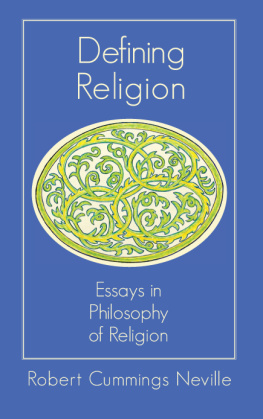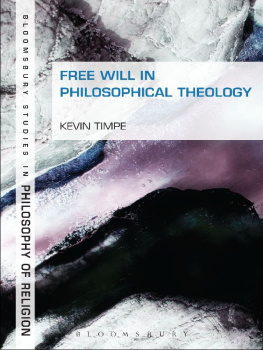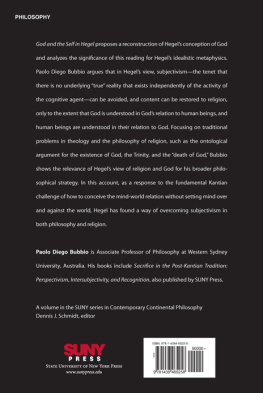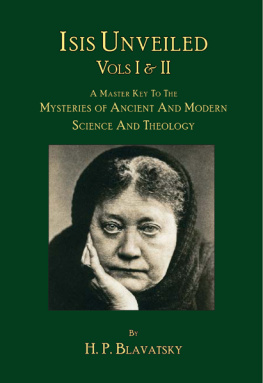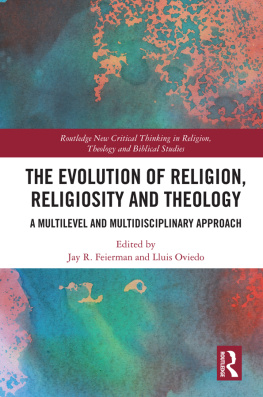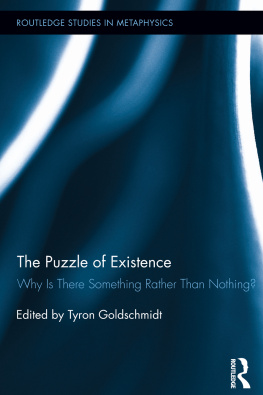existence
ROBERT CUMMINGS NEVILLE
existence
P HILOSOPHICAL T HEOLOGY
VOLUME TWO
State University of New York Press
Cover art: Existence by Beth Neville
Graphite pencil and colored pens on Bristol board paper, 10"x10", January, 2013
Published by
S TATE U NIVERSITY OF N EW Y ORK P RESS , A LBANY
2014 State University of New York
All rights reserved
Printed in the United States of America
No part of this book may be used or reproduced in any manner whatsoever without written permission. No part of this book may be stored in a retrieval system or transmitted in any form or by any means including electronic, electrostatic, magnetic tape, mechanical, photocopying, recording, or otherwise without the prior permission in writing of the publisher.
For information, contact
S TATE U NIVERSITY OF N EW Y ORK P RESS , A LBANY , NY
www.sunypress.edu
Production, Laurie Searl
Marketing, Kate McDonnell
Library of Congress Cataloging-in-Publication Data
Neville, Robert C.
Existence : philosophical theology / Robert Cummings Neville.
pages cm
Volume two.
Includes bibliographical references and index.
ISBN 978-1-4384-5331-6 (hardcover : alk. paper)
1. Theological anthropology. 2. Philosophy and religion. 3. Ontology. I. Title.
BL256.N48 2014
218dc23 | 2013046365 |
10 9 8 7 6 5 4 3 2 1
for Nikolas Zanetti
The art on the cover of this volume is by Beth Neville, my wife, who has provided art for many of my SUNY Press books. She has my great thanks, as I said in the first volume of this Philosophical Theology. Like the cover art she did for Ultimates: Philosophical Theology Volume One, the colored-ink drawing for this volumes cover symbolically expresses its central themes. Though a square, the linear orientation is horizontal, indicating that this volume is about the human condition. The strongest horizontals are the two double cones pointing left and right with their longest ends. The human condition is of interest here because of the bearing it has on what is ultimate, symbolized most strongly by the touching of the tips of the short ends of the cones in the middle. The fact that the drawing has mirror images of left and right sides reflects the balanced importance of the two main topics of the human condition considered under the aspect of ultimacy, namely, human predicaments and ecstatic fulfillments. One of the main compositional elements is the strong horizontal thrusts of lateral semi-circles whose apexes are in the opposite side of the drawing from that in which their ends leave the picture. There are four of these semi-circles on each side, symbolizing the four cosmological ultimates that function in human predicaments and ecstatic fulfillments, respectively. Given that their arms cross one another, they inscribe four almond shapes in the center, indicating ultimacy, while they extend beyond their embrace to point to what lies beyond any finite harmony. On each side of the drawing are two portions of smaller semi-circles that originate in that side but extend outward without crossing to the other side, calling to mind the influence on any thing of other things outside it, and vice versa. Thus each thing is shown to harmonize its own components while including among those components the influences of other things and in turn influencing the others; nothing stands without internal integrity and external reference. The emotional and value intensity of the human condition has some cooling moments, but more red-hot connections, and at the center, the yellow fire of ultimacy. The argument of the book elaborates this symbolism.
Contents
Cross References
As a systematic work, the three volumes of Philosophical Theology involve much cross-referencing among its parts. Although each of the volumes has a primary titleUltimates, Existence, Religionthe cross-references are to the volumes by number. Cross-references are in endnotes on the occasion where commentary is required; otherwise they are in the text. The general rubric for cross-referencing is this: Cross-references will always be in italics, and this means that they refer to volumes of Philosophical Theology; the first roman numeral refers to the volume. If the reference is to a chapter, the volume number will be given first, followed by a comma, then the chapter number as an arabic number, and perhaps if needed a comma followed by a section number in lower-case roman numerals. So, Volume II, Chapter 3, Section IV would be II, 3, iv. If the reference is to a part in the volume, the roman volume number is first, followed by a comma and pt for part and an arabic numeral for the number of the part. So, Volume II, Part III would be II, pt. 3. Often a part is referred to as a whole; but if the reference is to the preliminary remarks or the summary implications, which are always keyed to parts, not chapters, then the referent to the part would be followed by a comma and pr and/or si. So, Volume III, Part IV, preliminary remarks and summary implications would be III, pt. 4, pr, si. If a reference does not indicate a volume number, this means the volume referred to is the one in which the reference is made. The text spells out titles of the three volumes when it discusses them directly.
Preface
The title of this second volume of Philosophical Theology is Existence, and the term is used in the sense associated with existentialism or the philosophy of existence. The volumes overall thesis is that the existential reality of religion is engaged in two primary and sometimes overlapping ways: confronting ultimately important human predicaments and confronting ecstatic ultimate human fulfillments. The existential reality of religion is a pregnant phrase that cannot be defined so much as built up and illustrated. Its philosophic work arises from the background of existentialism in late Western thought and was contextualized in the Christian theologies of Rudolph Bultmann and Paul Tillich, among others. The influence of existentialism on construing religion in existential ways was not limited to its Western sphere. Keiji Nishitani and others in Japan, formulating a late-modern form of Buddhist philosophy or theology, dealt explicitly with the existentialist literature. Following Tillichs language, we can delimit the existential reality of religion as those things that define a person ultimately. This is the primary meaning of the title, Existence; Nishitani explicitly used the term Existenz, as did Karl Jaspers.
Ultimates: Philosophical Theology One described these things that define a person ultimately as pertaining to anthropological ultimates (I, intro.; I, 5). The thesis here is that there are two kinds of things that define a person ultimately: engagements with ultimate predicaments of the human condition, and engagements with ultimate realities that ecstatically deliver a person beyond personal self-definition and into definition in terms of the ultimate realities themselves. From the perspective of ecstatic fulfillment, the human predicaments are not as important as they sometimes seem. Nishitani and Tillich agreed that the ecstatic relation to the ground of finite beings is the most fundamental reality of human beings and their most profound fulfillment, relativizing all others.


